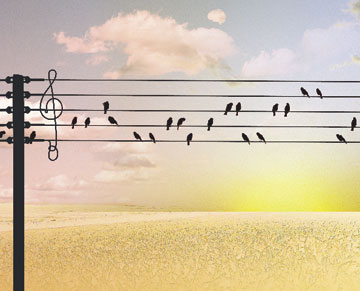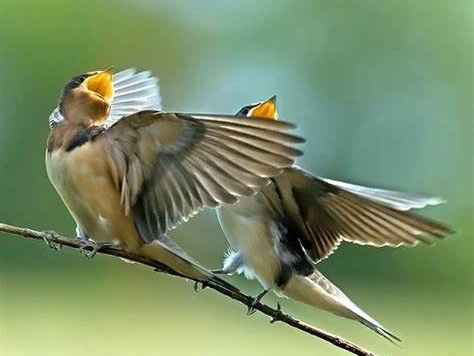INTERNATIONAL DAWN CHORUS DAY
Spring has truly sprung when the air fills with an intensity of collective twittering’s, tweeting’s and chirps building to a crescendo. The sound is unmistakable.
The dawn chorus is a phenomenon that occurs at the start of a new day and is most noticeable and recognisable in spring. In the UK, the dawn chorus begins in March, reaching its peak in May coinciding with International Dawn Chorus Day.
Every dawn chorus is unique as the sheer variety of birds singing in unison means no two dawn choruses are quite the same and the best days to choose to listen to the dawn chorus are those with fine, clear weather and little wind.
It starts with a few songs at different times and just like an orchestra there is a set sequence; robins, blackbirds, and thrushes – just before dawn who are soon joined by others like woodpigeons, wrens and warblers, while great tits, blue tits, sparrows and finches only add their voices when it’s light enough for them to see until all the birds in the area are singing together.
Early mornings are too dark for birds to search for food and too dark to be spotted by predators which makes it the perfect time to sing. There is less background noise in early mornings with the air being so still that sound carries around 20 times further than it would later in the day.
International Dawn Chorus Day is held on the first Sunday in May each year, which falls on May 3rd in 2020.
The event is promoted by the Wildlife Trust and this is the perfect opportunity for nature lovers to listen to the sounds of birds as they sing to greet the rising sun. However, you do not even need to leave your home to hear the dawn chorus, just throw open your windows before it gets light!
Green spaces like woods and parks are best or the countryside, but you can just step outside and listen if there are trees on your street or you’ve got shrubs and bushes in your garden. It’s something definitely worth waking up early for!
Dawn is the best time as the song of a bird carries further meaning you can hear it much more clearly, in fact up to 20 times more than at midday. Dawn chorus peaks half-an-hour before to half-an-hour after sunrise, but the variety of song can prove too confusing at that time. You will need to be an early bird if you want to catch the first few songs or identify individual birds., so it’s best to get into position a good hour before sunrise to enjoy the arrival of each performer as their take their turn and hear the new voices joining the chorus.
The dawn chorus is all about defending territory and attracting mates. The singing is typically carried out by male birds and the song of a male can indicate his quality as a mate in several ways, particularly the song sung during the dawn chorus. Only the strongest, best-fed males will produce the loudest songs as making so much noise uses up a lot of energy which demonstrates to females they are fit, healthy and hold a territory with plenty of food.
Male birds will also amplify their song by singing on high exposed perches. A loud song also serves as a deterrent for any rival males who may be looking to move in. A weaker, hungry bird will not have the energy to sing for long.
Most birds have a syrinx which works just like human vocal cords located where the windpipe forks into the lungs producing multiple tones at the same time, hence the complexity of sound in a single bird's song.
According to research, birds in towns and cities have higher pitched calls than those in the country. This enables their calls to better bounce off the hard surfaces of urban areas.
Songbirds can be divided into oscines and suboscines. While oscines (regarded as the true songbirds) learn their songs from their father or a neighbour, suboscines do not. Research has found that even though raised them in acoustic isolation, they are still able to reproduce the precise song of their species despite never having heard it.
The dawn chorus begins in the spring to coincide with the beginning of the breeding season. The level of melatonin which is a natural hormone the brain releases in response to changes in light which helps to regulate their internal clock, signalling when it is time to go to sleep. However, in birds it is regulated by daylight and decreases as days get longer and lighter. This combined with an increase in testosterone triggers breeding activity and the dawn chorus and battle for territory and mates begins.
The best dawn choruses can only be heard for a short time because migrant birds have arrived in the UK and are making themselves known in order to secure territory.
Imitating another bird’s song will increase their repertoire and show females that they have survived enough breeding seasons to have heard these other songs with some migratory birds even imitating international birds. Marsh warblers, for example, can mimic the sounds of up to 70 different species showing females where they have spent the winter.
Birds will often leave gaps in their songs and listen for replies so they can work out where their rivals are and focus their efforts on birds looking to take over their territory. Some birds such as chaffinches and great tits have a big repertoire of different songs in order to convince other males that there are a number of birds in the area and all territory is taken.
The most successful males will find mates early in the season and can sometimes rear two broods during the spring and summer. However, this decreases their reproductive success and their singing will also lessen over the breeding season.
In many species, once the female has been attracted, the male will sing less often. A bird that sings on and on, late into the season, is probably a lonely bachelor who has failed to attract a mate.
So the early bird really does catch more than just the worm!


